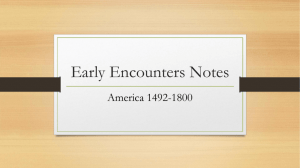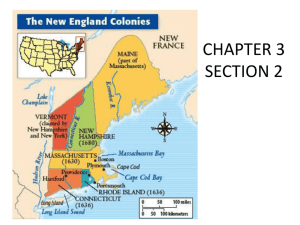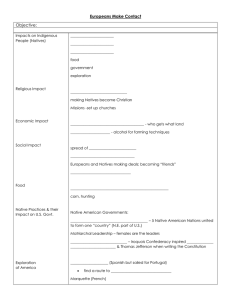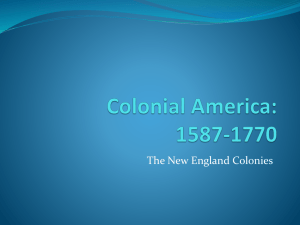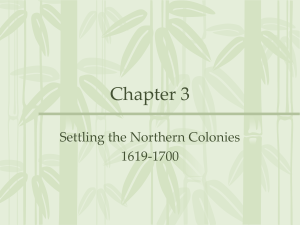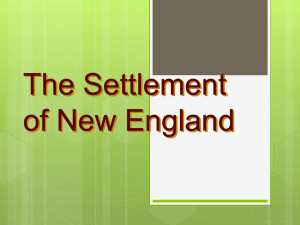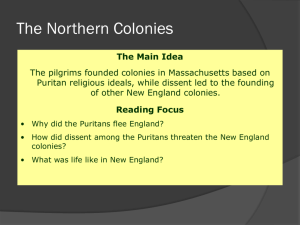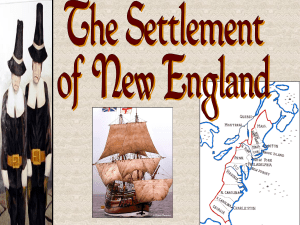Chapter 2 Section 3: The New England Colonies
advertisement
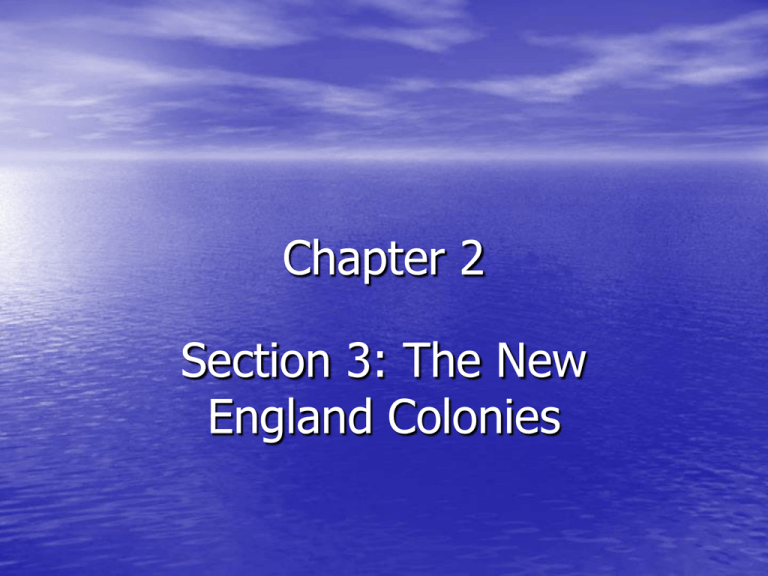
Chapter 2 Section 3: The New England Colonies The French in North America • Giovanni de Verrazzano –Sailed in 1524 searching for the Northwest Passage –Explored North Carolina to Newfoundland • Jacques Cartier –3 voyages to Canada 1534, 1535, & 1541 –New France (Canada & Northern US) –St Lawrence River –No permanent settlement • Samuel de Champlain –1st colony in 1608 Quebec –Mapped the Atlantic Ocean south to Massachusetts & traveled into Lakes Champlain & Huron • Louis Joliet & Jacques Marquette –Traveled from the Great Lakes to the Mississippi River in 1673 •Followed it to Arkansas The Fur Trade • Determined to shape of New France- close to water • The Natives trapped the animals, collected their furs & traded them to the French The Iroquois • Natives provided a market for European goods • Natives learned & adopted Catholicism • Europeans brought diseases –Natives tried to capture members of other groups for shrinking lineages • Natives fought with each other over hunting grounds • Live in NY between the Hudson & Lake Erie –They pushed their rivals out of their home lands forcing them to migrate west of the Great Lakes Plymouth Colony • New England ColoniesConnecticut, Rhode Island, Massachusetts, Vermont, New Hampshire, & Maine • Puritans & Separatists –1534 King Henry VIII had broken with the Catholic Church & founded the Anglican Church (English National Protestant Church) • Some complained the Anglican Church continued too many Catholic practices & traditions • Wanted a “purer” church (Puritans) –Some broke away (Separatists) The Voyage of the Mayflower • Pilgrims decided to make a new home in North America • 1620 100 Pilgrims sailed on the Mayflower –2/3 were non-Separatists & threatened to go off & live by themselves • Afraid that the group would break up, the Pilgrims made up the Mayflower Compact –Succeeded in keeping them together –Showed that the Pilgrims expected to decide for themselves how they would be governed • William Bradford went on to be governor of the colony 30 times between 1621 & 1656 • Helped create a form of government in which the people guided their own affairs Early difficulties • Half died in the first winter • Helped by Squanto who taught them to plant corn The Massachusetts Bay Colony • North of Plymouth • Great Migration • Reasons for Migrating –Religious tolerance •Didn’t believe in •Did want everyone to be Puritans –Reform the Protestant Church Transforming New England • Replaced forests with fields, cultivated wheat, barley, & corn, raised cows & pigs • Attempted to remake the Natives A city upon a hill • Puritans insisted that social order begins with personal order –Frowned on people who wanted to live alone • Work together with shared goals The Salem Witch Trials • 1692- several girls claimed that the devil had taken control of them & accused people of being witches • Trials were held to determine who were witches –20 men & women were executed Other Puritan colonies • Farmland grew scarce in Mass. • Connecticut-Led by Thomas Hooker • New plan of governmentFundamental Orders • New Hampshire-Separate colony in 1679 • Maine- part of Mass. until 1820 Dissent in the Puritan Community • Roger Williams founded Providence –1635 banished from Mass. After quarrelling with Puritan authorities –One issue was land rights •Thought land should be bought from the natives • Another issue was religious tolerance –Government shouldn’t interfere • Colony granted religious tolerance to all settlers Other Separatists Colonies • 1638- New Haven Colony • 1662 New Hampshire & Connecticut combined under a royal charter • 1638- John Wheelwright founded Exeter, in NH The Banishment of Anne Hutchinson • Believed it was wrong to obey the church, if they felt they were disobeying God • She went to trial in Nov. 1637 –Judges rejected her claim that her own beliefs about God could override the authority of Puritan laws & leaders War with the Indians • Caused because English settlers were pushing Natives out of their homes • The Pequot War –Connecticut struck back in 1637 –Puritans burned down a Pequot fort killing 500 –They went on a hunt to kill or capture the rest King Phillip’s War • Thursday June 24, 1675 –Wampanoag killed cows in the pasture •Killed one by owner •Saw it as a good sign because the “wise man” said they could win a war if the white man shot first • Hostilities because of Metacom or “King Phillip” • Metacom united Indian groups from RI to Maine to drive out the English –Destroyed more than 20 English towns & killed 2,000 people •Ruined fields, slaughtered cattle, & kidnapped people • English retaliated killing 4,000 Natives –United because of language & customs –English received help from the natives • Aug. 1676- Metacom shot in the heart –War went on for another year devastating the economy
